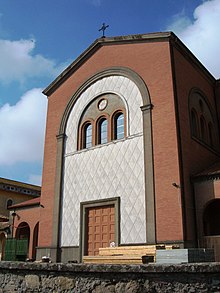Porto and Santa Rufina
|
Suburbicarian Diocese of Porto-Santa Rufina Portuensis-Sanctae Rufinae |
|
|---|---|

La Storta (Roma) Cathedral
|
|
| Location | |
| Country | Italy |
| Ecclesiastical province | Rome |
| Statistics | |
| Area | 2,000 km2 (770 sq mi) |
| Population - Total - Catholics |
(as of 2004) 307,000 300,000 (97.7%) |
| Parishes | 52 |
| Information | |
| Denomination | Catholic Church |
| Rite | Roman Rite |
| Established | 3rd century |
| Cathedral | Cattedrale dei Sacri Cuori di Gesù e Maria (La Storta) |
| Co-cathedral | Chiesa di SS. Ippolito e Lucia (Portus) |
| Current leadership | |
| Pope | Francis |
| Bishop | Gino Reali |
| Website | |
| www.diocesiportosantarufina.it | |
The Diocese of Porto and Santa-Rufina (Lat: Portuensis et Sanctae Rufinae) is a suburbicarian see of the Holy Roman Church and a diocese of the Catholic Church in Italy. It was formed from the union of two suburbicarian sees of Rome.
From 1967, the diocese has had both a titular Cardinal bishop, and a resident bishop who handles the diocesan business.
Porto was in ancient times Portus, the chief harbour of Rome. It owes its origin to the port built by Claudius on the right of the Tiber, opposite Ostia; Trajan enlarged the basin, and in a short time there grew around it a city which soon became independent of Ostia.
It was near Porto that Julius Nepos compelled Emperor Glycerius to abdicate (474). During the Gothic War the town served the Goths (537 and 549) and the Byzantines (546-52) as a base of operations against Rome. In the 9th and 10th centuries it was sacked on several occasions by the Saracens. In 849 Pope Leo IV fortified it and established there a colony of Corsicans for the defence of the coast and the neighbouring territory; but the city continued to decay.
Christianity was early established there. Several martyrs of Porto are known, including Herculanus, Hyacinthus, Martialis, Saturninus Epictetus, Maprilis and Felix. The place was also famous as the probable see of St. Hippolytus.
In 314 Gregorius was bishop. The great xenodochium, or hospice, of Pammachius was built about 370.
Santa Rufina grew up around the basilica of the Holy Martyrs Sts. Rufina and Secunda on the Via Aurelia, fourteen miles (21 km) from Rome; the basilica is said to have been begun by Pope Julius I, and was finished by Saint Damasus. In the 9th century this town was destroyed by the Saracens, and the efforts of Pope Leo IV and Pope Sergius III were unable to save it from total ruin: all that remains are the remnants of the ancient basilica and a chapel.
...
Wikipedia
